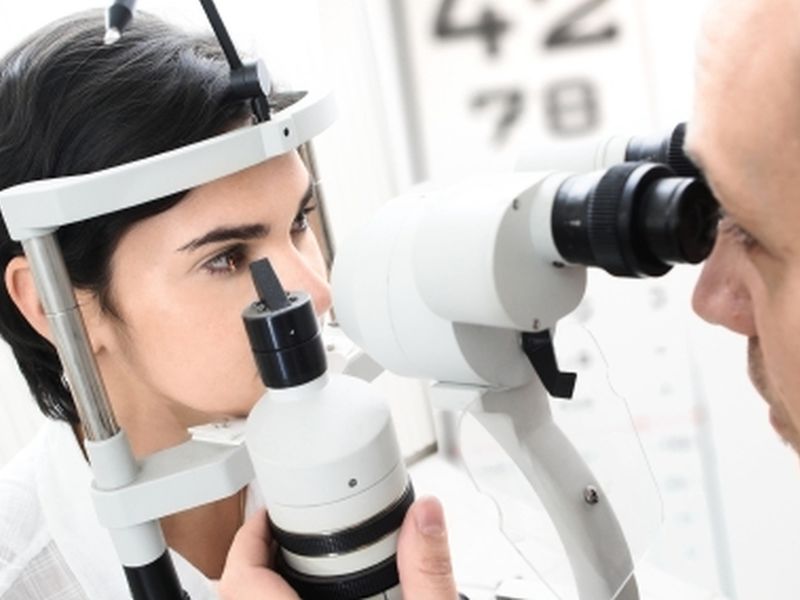

'Halo' Effect Common After Lasik Eye Surgery
But post-op problems typically clear up over time, specialist says
Friday, December 2, 2016


FRIDAY, Dec. 2, 2016 (HealthDay News) -- Nine out of 10 Lasik laser eye surgery patients report satisfaction afterwards. But a sizable percentage experience new visual disturbances -- like seeing halos around lights -- up to six months after the procedure, a new study finds.
"While Lasik has long since been proven safe and effective over decades of use, a small but significant subset of patients report post-operative effects including glare, halos and other vision symptoms, as well as dry eyes," said Dr. Christopher Starr. He's an associate professor of ophthalmology at Weill Cornell Medicine/NewYork-Presbyterian Hospital in New York City.
"These effects typically resolve over time, either during the healing process, which can take up to 12 months, or with additional treatments if needed," said Starr, who wasn't involved in the new study.
Of hundreds of patients surveyed, fewer than 1 percent said any single problem disrupted their day-to-day lives. Still, these concerns may be more common than previously thought, the researchers discovered.
Lasik laser eye procedures treat poor near and far vision and astigmatism, a condition that distorts images. Millions of Americans hoping to shed eyeglasses or contact lenses have undergone Lasik surgery since its development more than 20 years ago.
To learn more about its after-effects, the U.S. Food and Drug Administration conducted two surveys between 2011 and 2014.
"Some of the problems reported included debilitating vision symptoms (seeing starbursts, glare, ghosting or halos) and severe dry eye," said Dr. Malvina Eydelman, an FDA division director and co-author of the two new reports. For some, everyday activities and nighttime driving become difficult, she noted.
However, Eydelman and Starr both said that the findings don't challenge assumptions about Lasik's safety and effectiveness, since the surveys weren't designed to explore those issues.
In one survey, researchers reviewed responses from 240 active-duty Navy personnel one and three months after Lasik surgery. Half were young adults.
The other study analyzed responses from 271 civilians, average age 32, up to six months after they had Lasik surgery at one of five centers in the United States.
"Up to 46 percent of participants who had no visual symptoms before surgery reported at least one visual symptom at three months after surgery," Eydelman said.
"They most often developed halos. Up to 40 percent of participants with no halos before Lasik had halos three months following surgery," she said.
In addition, up to 28 percent of participants with no symptoms of dry eyes before Lasik reported them three months after their surgery, Eydelman added.
"This is consistent with previous studies," she said.
However, more than 90 percent of patients reported satisfaction. And those who did reveal complaints didn't necessarily seek help for them.
"Participants were more than twice as likely to report their visual symptoms on a questionnaire than to tell them to their health care provider," Eydelman said.
Whether people of a certain age or gender are more susceptible to these post-op disturbances could not be determined, she noted.
Starr said the questionnaire can be administered to help researchers further understand how Lasik-related eye problems affect people's lives.
"Due to modern technological sophistication, there likely has never been a better time to have laser vision correction surgery," Starr said. He noted that a recent review of 4,400 Lasik clinical studies conducted between 2008 and 2015 found patients are experiencing "better visual outcomes" than ever before.
However, "Lasik isn't for everyone," Starr said.
"There are some patients who are better off staying in contact lenses or glasses rather than having laser vision correction surgery," he added. "This speaks to the importance of careful screening, and an open and honest dialogue between patient and doctor about risks and benefits."
The study was published online recently in the journal JAMA Ophthalmology.
SOURCES: Christopher Starr, M.D., associate professor, ophthalmology, Weill Cornell Medicine/NewYork-Presbyterian Hospital, New York City; Malvina Eydelman, M.D., division director, division of ophthalmic and ear, nose and throat devices and Office of Device Evaluation, Center for Devices and Radiological Health, U.S. Food and Drug Administration; Nov. 23, 2016, JAMA Ophthalmology, online
HealthDay
Copyright (c) 2016 HealthDay. All rights reserved.
News stories are provided by HealthDay and do not reflect the views of MedlinePlus, the National Library of Medicine, the National Institutes of Health, the U.S. Department of Health and Human Services, or federal policy.




























.png)











No hay comentarios:
Publicar un comentario